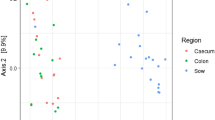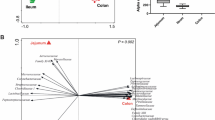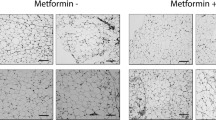Abstract
Currently 15% of U.S. infants are fed soy formulas that contain up to 14 mg of genistein equivalents/L. Our goal was to investigate the impact of dietary genistein on intestinal development. Piglets (n = 8/group) were fed sow milk replacer (MR), MR + 1 mg/L of genistein (LG), or MR + 14 mg/L of genistein (HG) for 10 d. Formula intake, weight gain, and intestinal length and weight were similar in all groups. Average serum genistein concentration in the HG group was similar to that of soy formula–fed infants. No significant effects of genistein on enterocyte apoptosis, lactase, and sucrase activities or electrophysiologic measures were observed in jejunum or ileum. Jejunal and ileal villus heights were not significantly different, but the percentage of proliferating cell nuclear antigen–positive jejunal crypt cells in the HG was reduced 50% compared with that in MR and LG (p = 0.001), indicating decreased proliferation. Enterocyte migration distance in the HG group tended to be 20% less (p = 0.1) than LG or MR. Jejunal estrogen receptor β mRNA expression in HG was half of that in LG (p = 0.05), but neither was significantly different from MR. In conclusion, genistein at the level present in soy infant formula is bioactive in the small intestine and results in reduced enterocyte proliferation and migration. The lack of effect of genistein on nutrient transport and enzyme activity suggests that the impact of genistein is greater on proliferating versus differentiated intestinal cells.
Similar content being viewed by others
Log in or create a free account to read this content
Gain free access to this article, as well as selected content from this journal and more on nature.com
or
Abbreviations
- BrdU:
-
5′-bromodeoxyuridine
- ER:
-
estrogen receptor
- HG:
-
high genistein
- ITF:
-
intestinal trefoil factor
- LC-MS:
-
liquid chromatography-mass spectrometry
- LG:
-
low genistein
- LPH:
-
lactase phlorizin hydrolase
- MR:
-
milk-replacer
- PCNA:
-
proliferating cell nuclear antigen
- SP:
-
spasmolytic polypeptide
- TFF:
-
trefoil factor
References
American Academy of Pediatrics 1997 Breastfeeding and the use of human milk. Pediatrics 100: 035–1039
American Academy of Pediatrics 1998 Soy protein-based formulas: recommendations for use in infant feeding. Pediatrics 101: 48–153
Motil K 2000 Infant feeding: a critical look at infant formulas. Curr Opin Pediatr 12: 69–476
Setchell KDR, Zimmer-Nechemias L, Cai J, Heubi JE 1997 Exposure of infants to phyto-oestrogens from soy-based infant formula. Lancet 350: 3–27
Setchell KDR, Zimmer-Nechemias L, Cai J, Heubi JE 1998 Isoflavone content of infant formulas and the metabolic fate of these phytoestrogens in early life. Am J Clin Nutr 68: 453S–1461S
Irvine CHG, Shand N, Fitzpatrick MG, Alexander SL 1998 Daily intake and urinary excretion of genistein and daidzein by infants fed soy- or dairy-based infant formulas. Am J Clin Nutr 68: 462S–1465S
Ménard D 1994 Development of human intestinal and gastric enzymes. Acta Paediatr Suppl 405: 1–6
Day AJ, Cañada FJ, Díaz JC, Kroon PA, Mclauchlan R, Faulds CB, Plumb GW, Morgan MRA, Williamson G 2000 Dietary flavonoid and isoflavone glycosides are hydrolysed by the lactase site of lactase phlorizin hydrolase. FEBS Lett 468: 66–170
Setchell KDR 1998 Phytoestrogens: the biochemistry, physiology, and implications for human health of soy isoflavones. Am J Clin Nutr 68: 333S–1346S
Setchell KDR, Brown NM, Desai P, Zimmer-Nechemias L, Wolfe BE, Brashear WT, Kirschner AS, Cassidy A, Heubi JE 2001 Bioavailability of pure isoflavones in healthy humans and analysis of commercial soy isoflavone supplements. J Nutr 131: 362S–1375S
Andlauer W, Kolb J, Stehle P, Fürst P 2000 Absorption and metabolism of genistein in isolated rat small intestine. J Nutr 130: 43–846
Andlauer W, Kolb J, Fürst P 2000 Isoflavones from tofu are absorbed and metabolized in the isolated rat small intestine. J Nutr 130: 021–3027
Morris SM, Akerman GS, Warbritton AR, Patton RE, Doerge DR, Ding X, Chen JJ 2003 Effect of dietary genistein on cell replication indices in C57BL6 mice. Cancer Lett 195: 39–145
Ren MQ, Kuhn G, Wegner J, Nurnberg G, Chen J, Ender K 2001 Feeding daidzein to late pregnant sows influences the estrogen receptor beta and type 1 insulin-like growth factor receptor mRNA expression in newborn piglets. J Endocrinol 170: 29–135
Thomas ML, Xu X, Norfleet AM, Watson CS 1993 The presence of functional estrogen receptors in intestinal epithelial cells. Endocrinology 132: 26–430
Gustafsson J-A 1999 Review: estrogen receptor β-a new dimension in estrogen mechanism of action. J Endocrinol 163: 79–383
Potten CS 1998 Stem cells in gastrointestinal epithelium: numbers, characteristics and death. Phil Trans R Soc Lond B 353: 21–830
Zava DT, Duwe G 1997 Estrogenic and antiproliferative properties of genistein and other flavonoids in human breast cancer cells in vitro. Nutr Cancer 27: 1–40
Kuo S-M 1996 Antiproliferative potency of structurally distinct dietary flavonoids on human colon cancer cells. Cancer Lett 110: 1–48
Dees C, Foster JS, Ahamed S, Wimalasena J 1997 Dietary estrogens stimulate human breast cells to enter the cell cycle. Environ Health Perspect 105: 33–636
Allred CD, Ju YH, Allred KF, Chang J, Helferich WG 2001 Dietary genistin stimulates growth of estrogen-dependent breast cancer tumors similar to that observed with genistein. Carcinogenesis 22: 667–1673
Chen A-C, Donovan SM 2004 Genistein at a concentration present in soy infant formula inhibits Caco2BBe cell proliferation by causing G2/M cell cycle arrest. J Nutr 134: 303–1308
Moughan PJ, Birtles MJ, Cranwell PD, Smith WC, Pedraza M 1992 The piglet as a model animal for studying aspects of digestion and absorption in milk-fed human infants. World Rev Nutr Diet 67: 0–113
Mount LE, Ingram DL 1971 The Pig as a Laboratory Animal. Academic Press, New York, pp 119–120
Houle VM, Schroeder EA, Odle J, Donovan SM 1997 Small intestinal disaccharidase activity and ileal villus height are increased in piglets consuming formula containing recombinant human insulin-like growth factor-I. Pediatr Res 42: 8–86
Houle VM, Park YK, Laswell SC, Freund GG, Dudley MA, Donovan SM 2000 Investigation of three doses of oral insulin-like growth factor-I on jejunal lactase phlorizin hydrolase activity and gene expression and enterocyte proliferation and migration in piglets. Pediatr Res 48: 97–503
Coward L, Kirk M, Albin N, Barnes S 1996 Analysis of plasma isoflavones by reversed-phase HPLC-multiple reaction ion monitoring-mass spectrometry. Clin Chim Acta 247: 21–142
Kles KA, Wallig MA, Tappenden KA 2001 Luminal nutrients exacerbate intestinal hypoxia in hypoperfused jejunum. JPEN J Parenter Enteral Nutr 25: 46–253
Dudley MA, Shulman RJ, Reeds PJ, Rosenberger JN, Putman M, Johnston PK, Perkinson JS, Nichols BL 1992 Developmental changes in lactase-phlorizin hydrolase precursor isoforms in the rat. J Pediatr Gastroenterol Nutr 15: 60–269
Peterson GL 1977 A simplification of the protein assay method of Lowry et al. which is more generally applicable. Anal Biochem 83: 46–356
Labarca C, Paigen K 1980 A simple, rapid, and sensitive DNA assay procedure. Anal Biochem 102: 44–352
Nicholson DW 1999 Caspase structure, proteolytic substrates, and function during apoptotic cell death. Cell Death Differ 6: 028–1042
Kowalski AA, Graddy LG, Vale-Cruz DS, Choi I, Katzenellenbogen BS, Simmen FA, Simmen RCM 2002 Molecular cloning of porcine estrogen receptor-β complementary DNAs and developmental expression in periimplantation embryos. Biol Reprod 66: 60–769
Ciacci C, Di Vizio D, Seth R, Insabato G, Mazzacca G, Podolsky DK, Mahida YR 2002 Selective reduction of intestinal trefoil factor in untreated coeliac disease. Clin Exp Immunol 130: 26–531
Committee on Medical Aspects of Food and Nutrition Policy 1999–2000 Annual Report. Department of Health, London, pp 28–29
Irvine CHG, Fitzpatrick MG, Alexander SL 1998 Phytoestrogens in soy-based infant foods: concentrations, daily intake, and possible biological effects. Proc Soc Exp Biol Med 217: 47–253
The Australian College of Paediatrics 1998 Position statement: soy protein formula. J Paediatr Child Health 34: 18–319
Merritt RJ, Jenks BH 2004 Safety of soy-based infant formulas containing isoflavones: the clinical evidence. J Nutr 134: 220S–1224S
Ostrom KM, Cordle CT, Schaller JP, Winship TR, Thomas DK, Jacobs JR, Blatter MM, Cho S, Gooch WM III, Granoff DM, Faden H, Pickering LK 2002 Immune status of infants fed soy-based infant formula with or without added nucleotides for 1 year: part 1: vaccine responses and morbidity. J Pediatr Gastroenterol Nutr 34: 37–144
Enmark E, Pelto-Huikko M, Grandien K, Lagercrantz S, Lagercrantz J, Fried G, Nordenskjold M, Gustafsson J 1997 Human estrogen receptor β-gene structure, chromosomal localization, and expression pattern. J Clin Endocrinol Metab 82: 258–4265
Kuiper GGJM, Lemmen JG, Carlsson B, Corton JC, Safe SH, Van Der Saag PT, Van Der Burg B, Gustafsson J 1998 Interaction of estrogenic chemicals and phytoestrogens with estrogen receptor β. Endocrinology 139: 252–4263
Dalu A, Blaydes BS, Bryant CW, Latendresse JR, Weis CC, Barry Delclos K 2002 Estrogen receptor expression in the prostate of rats treated with dietary genistein. J Chromatogr B Analyt Technol Biomed Life Sci 777: 49–260
Patisaul HB, Melby M, Whitten PL, Young LJ 2002 Genistein affects ER beta- but not ER alpha-dependent gene expression in the hypothalamus. Endocrinology 143: 189–2197
Booth C, Hargreaves DF, Hadfield JA, McGown AT, Potten CS 1999 Isoflavones inhibit intestinal epithelial cell proliferation and induce apoptosis in vitro. Br J Cancer 80: 550–1557
Migliaccio A, Castoria G, Di Domenico M, de Falco A, Bilancio A, Lombardi M, Barone MV, Ametrano D, Zannini MS, Abbondanza C, Auricchio F 2000 Steroid-induced androgen receptor-oestradiol receptor β-Src complex triggers prostate cancer cell proliferation. EMBO J 19: 406–5417
Di Domenico M, Castoria G, Bilancio A, Migliaccio A, Auricchio F 1996 Estradiol activation of human colon carcinoma-derived Caco-2 cell growth. Cancer Res 56: 516–4521
Salti GI, Grewal S, Mehta RR, Das Gupta TK, Boddie AW, Constantinou AI 2000 Genistein induces apoptosis and topoisomerase II-mediated DNA breakage in colon cancer cells. Eur J Cancer 36: 96–802
Groos S, Reale E, Luciano L 2003 General suitability of techniques for in situ detection of apoptosis in small intestinal epithelium. Anat Rec 272A: 03–513
Grossmann J, Walther K, Artinger M, Rümmele R, Woenckaus M, Schölmerich J 2002 Induction of apoptosis before shedding of human intestinal epithelial cells. Am J Gastroenterol 97: 421–1428
Mashimo H, Wu DC, Podolsky DK, Fishman MC 1996 Impaired defense of intestinal mucosa in mice lacking intestinal trefoil factor. Science 274: 62–265
Podolsky DK 2000 Mechanisms of regulatory peptide action in the gastrointestinal tract: trefoil peptides. J Gastroenterol 35: 9–74
May FEB, Westly BR 1997 Expression of human intestinal trefoil factor in malignant cells and its regulation by oestrogen in breast cancer cells. J Pathol 182: 04–413
Di Domenico M, Castoria G, Bilancio A, Migliaccio A, Auricchio F 1996 Estradiol activation of human colon carcinoma-derived Caco-2 cell growth. Cancer Res 56: 516–4521
Wang H, Murphy PA 1994 Isoflavone content in commercial soybean foods. J Agric Food Chem 42: 666–1673
Rao AV, Sung MK 1995 Saponins as anticarcinogens. J Nutr 125: 17S–724S
Author information
Authors and Affiliations
Corresponding author
Additional information
This research was funded by the State of Illinois through the Illinois Council on Food and Agricultural Research.
Rights and permissions
About this article
Cite this article
Chen, AC., Berhow, M., Tappenden, K. et al. Genistein Inhibits Intestinal Cell Proliferation in Piglets. Pediatr Res 57, 192–200 (2005). https://doi.org/10.1203/01.PDR.0000150723.87976.32
Received:
Accepted:
Issue date:
DOI: https://doi.org/10.1203/01.PDR.0000150723.87976.32



